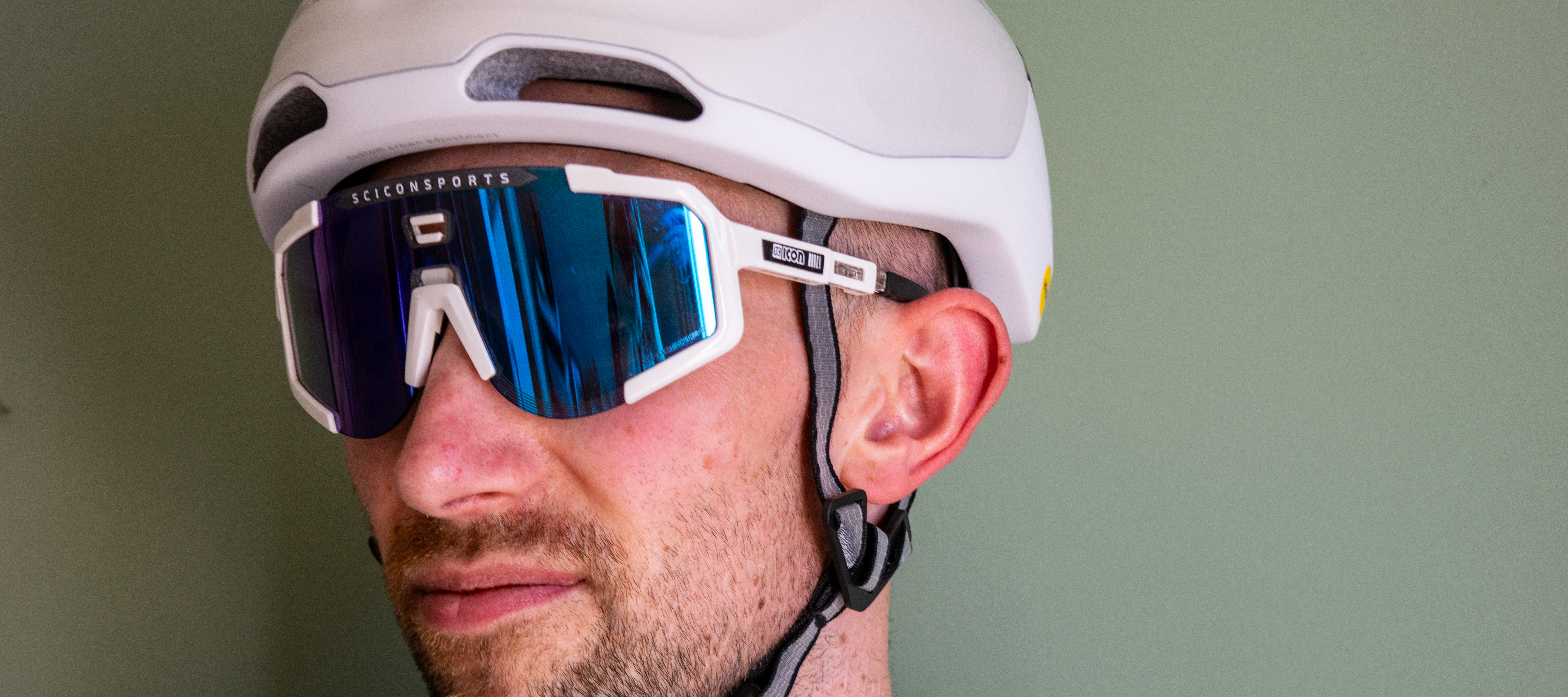Cyclingnews Verdict
The Scicon Aeroscope glasses come in a nice overall package and have a large on-trend frame design and shape. Lens clarity is very good, and they are very adjustable. Nose piece comfort isn't as good for me, and the frames do get in the way somewhat when checking behind your shoulder.
Pros
- +
Clear, crisp lens performance
- +
Adjustability helps tailor-fit
- +
Funky, on-trend design and aesthetic
Cons
- -
The corner of the frame obstructs vision when looking behind
- -
May be on the large side for some riders
- -
The nose piece isn't the most comfortable
You can trust Cyclingnews
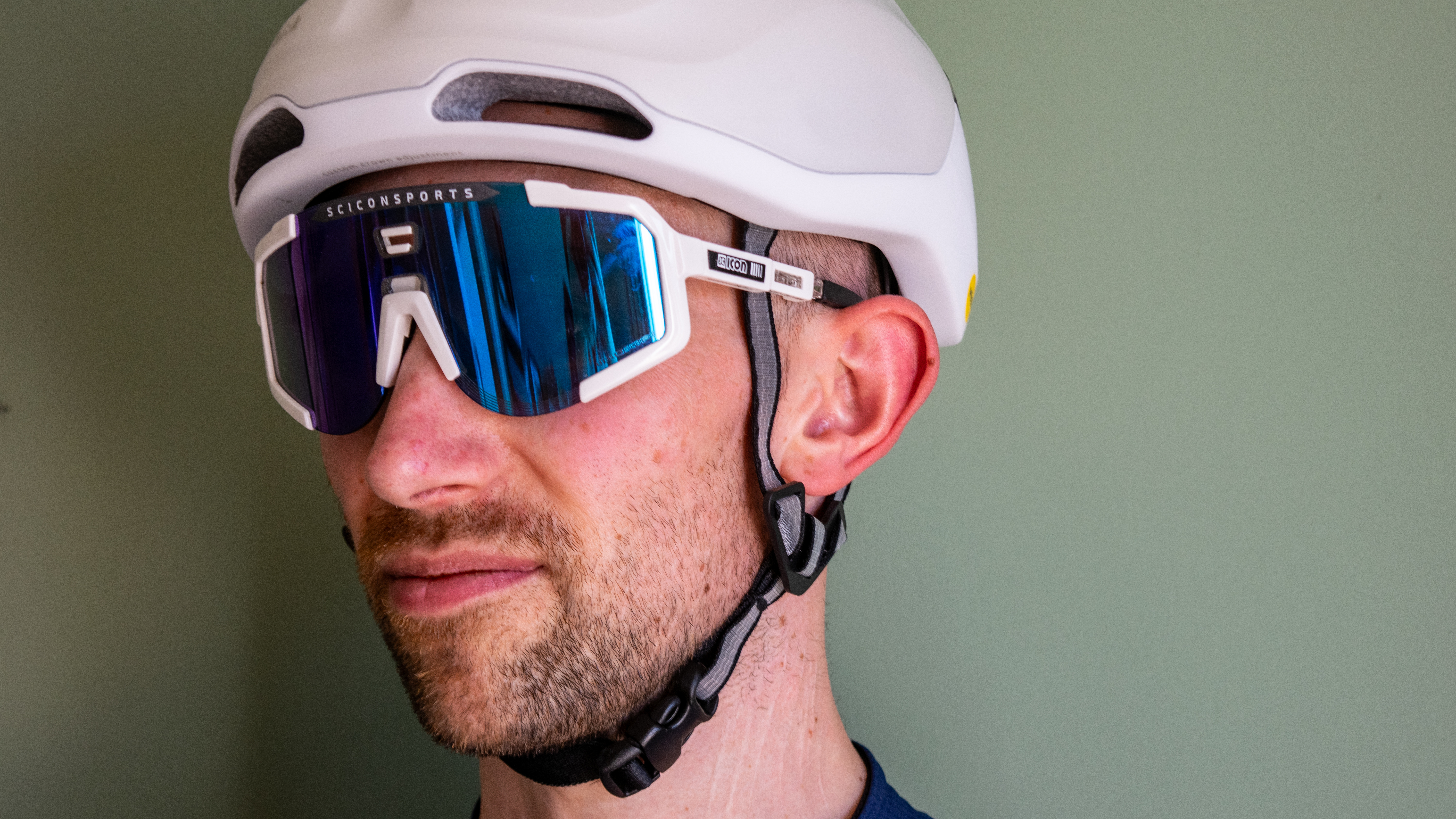
Price: £195 / $230 / €250
Weight: 38 grams / 1.34oz
Lens options: 10
It’s hard to escape the name Tadej Pogačar at present; the Slovenian World Champion is close to unbeatable right now, as he proved by winning La Flèche Wallonne and Liège-Bastogne-Liège within the space of a few short days recently.
This is a theme I fear that has no signs of stopping, and my next sunglasses review reinforces it as I test out a pair of Scicon Aeroscope sunglasses, a pair from the Italian brand's range that have been worn by Pogačar himself regularly to race in, in a variety of versions.
The Aeroscopes are high-end cycling-specific shades that are available in a healthy range of frame colour and lens option combinations, there are close to 30 variants in total. The lenses are interchangeable, and the length of the arms and nose piece are adjustable to fine-tune the fit.
They start at $230 and rise in price up to $325 if you want to run an optical insert to suit your personal eye prescription. There’s even a rainbow coloured world champion edition for $260 if you really want to go all out and celebrate the world champion's incredible achievements.
These shades sit amongst various larger framed options that are on the market now., so if you are shopping for a pair of up-to-date, big-framed cycling shades like the POC Devour, the Oakley Velo Kato, these will be up your street, but are they good enough for inclusion in our best cycling glasses guide?
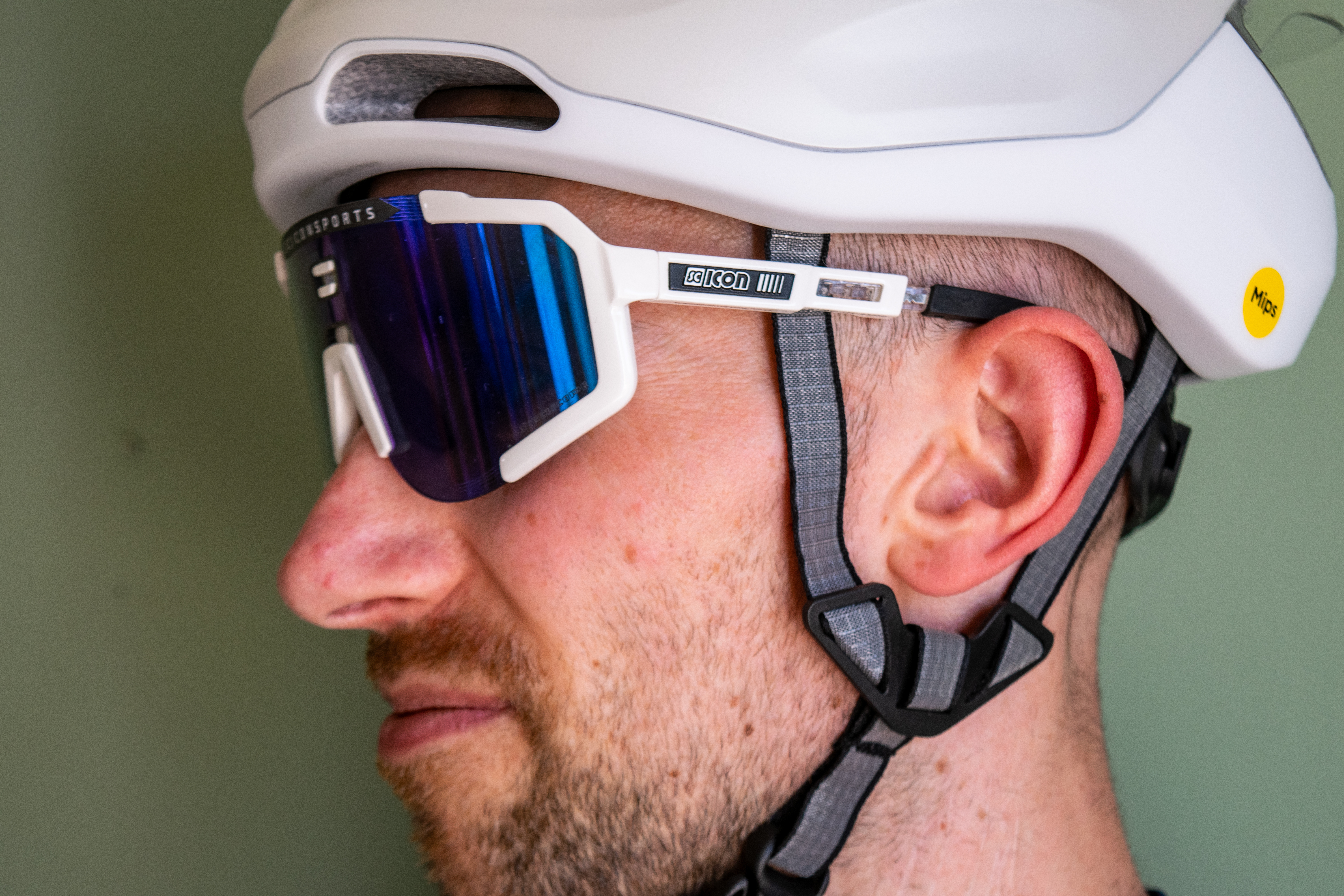
Design and aesthetics
The Aeroscopes have been on the market for a couple of years, and we covered their launch back in May 2023.
Since then, they have been worn for a Tour of Flanders win among others by Pogačar, but the Slovenian could probably win in a pair of scuba goggles, so let's see how they do for the regular rider.
The latest race content, interviews, features, reviews and expert buying guides, direct to your inbox!
Out of the box, you get quite a nice overall package with the Aeroscopes. Each pair comes in a soft bag, which can double as a saddle bag as a nice touch. Inside is a plush sunglasses drawstring bag, which has an additional pouch for the spare lens that each pair comes with.
Both bags feel quality, super soft and plush internally, and the drawstring bag is thicker than most I have seen. Option-wise, I’ve been testing the white gloss, multimirror blue lens combo, which retails for $230.
There is a good bit of branding on the shades, I count five 'Scicon' wordmarks altogether, as well as other bits of branding. It all contributes to the techy feel and doesn't feel overdone for me.
Thankfully, they're nowhere near as heavily branded as the Aeroshade Kunken, which launched in 2022 with a repeating Scicon logo etched onto the lens.
Lots of potential sunglasses negatives are ticked off with these shades straight out of the gate. The arms fold, unlike the Oakley Velo Kato. The lenses are easily interchangeable, another plus point, and Scicon has gone further by adding adjustable arms alongside the adjustable nose piece.
Swapping lenses is easy, just push the central tab just above the nose piece in, and pull each side of the frames off away and off from the lens itself. It can be done in under two minutes easily.
A wide range of spares is also available on the Scicon website, and Scicon will replace your lenses once, free of charge, if visibility or performance is affected by a scratch or crash damage.
If you scratch them in use, you’ll just need to pay the shipping and have proof of ownership. That’s not bad in my book.
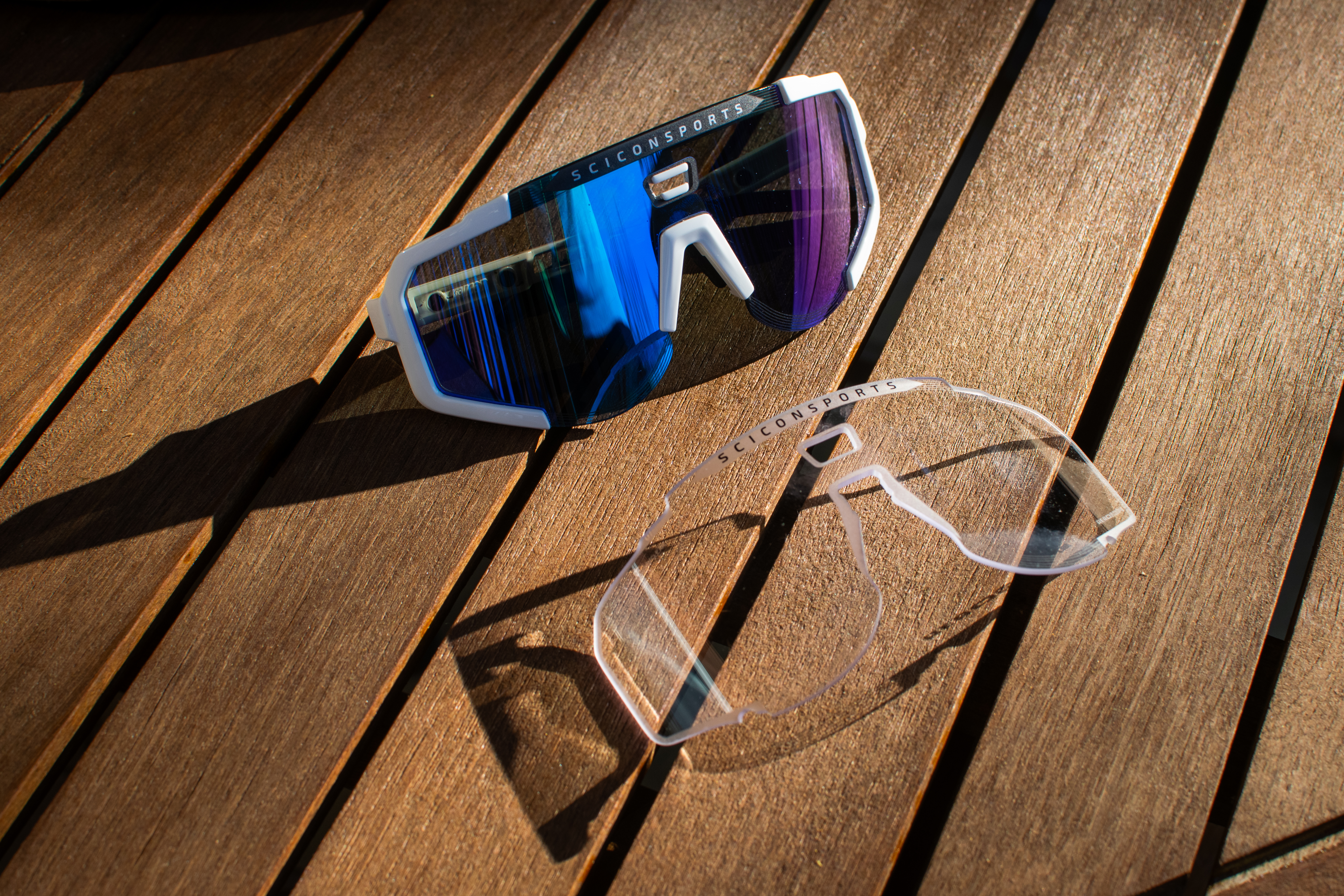
In terms of the design itself, the shades are made in Italy and the frames themselves use a Grilamid TR90 base. In plain speak, this means that the frames use a polyamide material that uses renewable materials. The cylindrical-shaped lenses are polycarbonate and have an Oleophobic (oil) and hydrophobic (water) coating.
The frame holds the lens all the way around, except at the very bottom of the rounded lenses. There’s a vent just above the nose piece, which also doubles as a sort of push button to free the lenses from the frames when you swap them in and out.
The arms have a metal core that’s coated in firm rubber, and they can be adjusted between 120-130mm in length using a series of indents on the plastic frames.
This does mean it would be possible to misplace an arm, so it's going to be best to make sure you keep everything together.
The frames and sunglasses overall have a robust, sturdy feeling about them. They aren’t superlight or flimsy, and this feeling, I think, is reinforced by the larger size.
There are a few other bits of tech from Scicon to mention. First off is what the brand calls Horizon adapt, the whole of the nose piece section can be adjusted down or up by 5mm to make things more comfortable, and the rubber nose pad itself can be adjusted.
The lens angle, which is dictated by the frames, has 12 degrees of forward tilt. Scicon claims this better suits a more aerodynamic riding position. I can't say I've noticed it massively on the bike, and it certainly hasn't been a negative for me.
The lenses themselves are the Scicon Performance (SCN-PP). They are 67mm tall and have an 11% visual light transmission number and sit in lens category three. This means the lenses are best suited to activities in brighter sunlight.
Lenses with lower VLT numbers are good for sunnier, clear days, so the multimirror blue lens here is indeed good for bright, sunny days. Check the lens VLT numbers on the brand's website if you want something really specific.
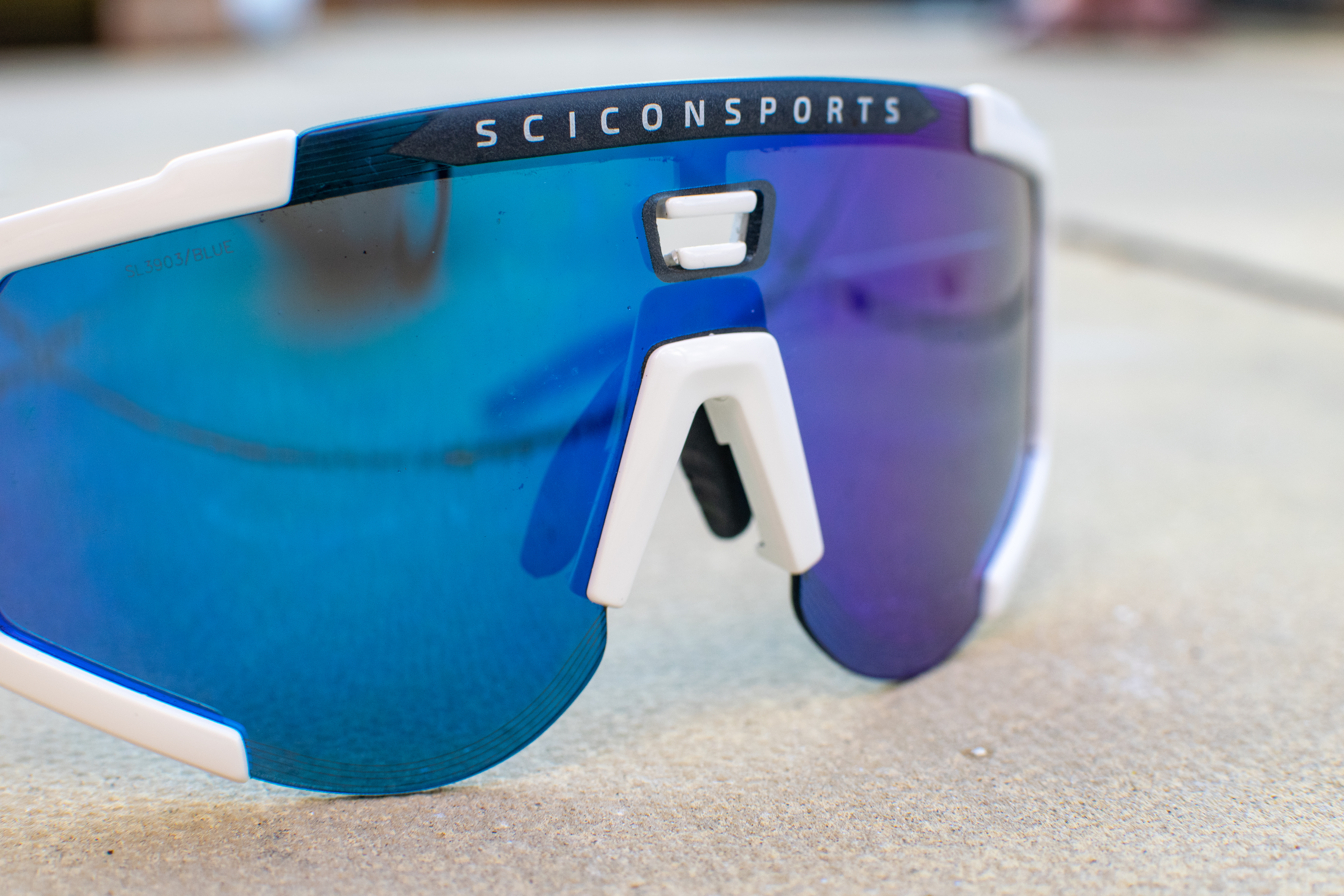
Performance
I've been wearing these glasses for a few months now. I've ridden across a good range of riding conditions on road, gravel in bright sunshine, in the dark, as well as while the sun was going down. I also took them with me to Spain and wore them for the recent Traka 100 and a few other gravel rides in Girona.
Lens performance and clarity have been very good for me, I don't have any complaints whatsoever. Oakley Prizm lenses are often regarded as a benchmark and these ones are as capable as my favourite Oakley Radars. I've no complaints.
A standout was riding hard in a single line with clubmates as the sun went down one evening recently. The last orange rays of sun were casting long shadows and distracting me as they burst over the tops of the hedges, but I could see what was in the gutter of the road and even pick out rocks and debris with total clarity while my heart rate was near its max. Don't worry about lens quality or sharpness, it's very good.
I ride fairly regularly in the dark and get out of the house pretty early each weekend to ride. I really like that this pair comes with a clear lens, it's a very useful option to have for any sunglasses with changeable lenses, a big tick in the value box there for me.
Face retention has been excellent, too, the glasses also didn't move an inch when worn on the back of my head for about fifty miles of a very wet, muddy Traka 100. I didn't need to waste mental energy worrying about them on rough descents, they didn't move an inch when I slid off on a rocky bend mere kilometres from the finish either.
Two areas where the Aeroscope loses points is in the comfort stakes and the field of vision when looking over your shoulder.
I don't find the nosepiece, despite its adjustability, completely comfortable. Despite its adjustability, which is a plus point, it's a little hard and small. It's not as well executed as some from Oakley, for example, which are softer and more comfy, at least on my face.
I have a small head and face, so maybe this contributes to things, but I have worn more comfortable glasses, the new Oakley Radar Plate glasses for example, which I am also currently testing.
Second is the fact that the frame is smack bang in the field of vision when looking over your shoulder. It isn't a total nightmare, but it does affect things somewhat, not the best for racing situations or checking over your shoulder in traffic.
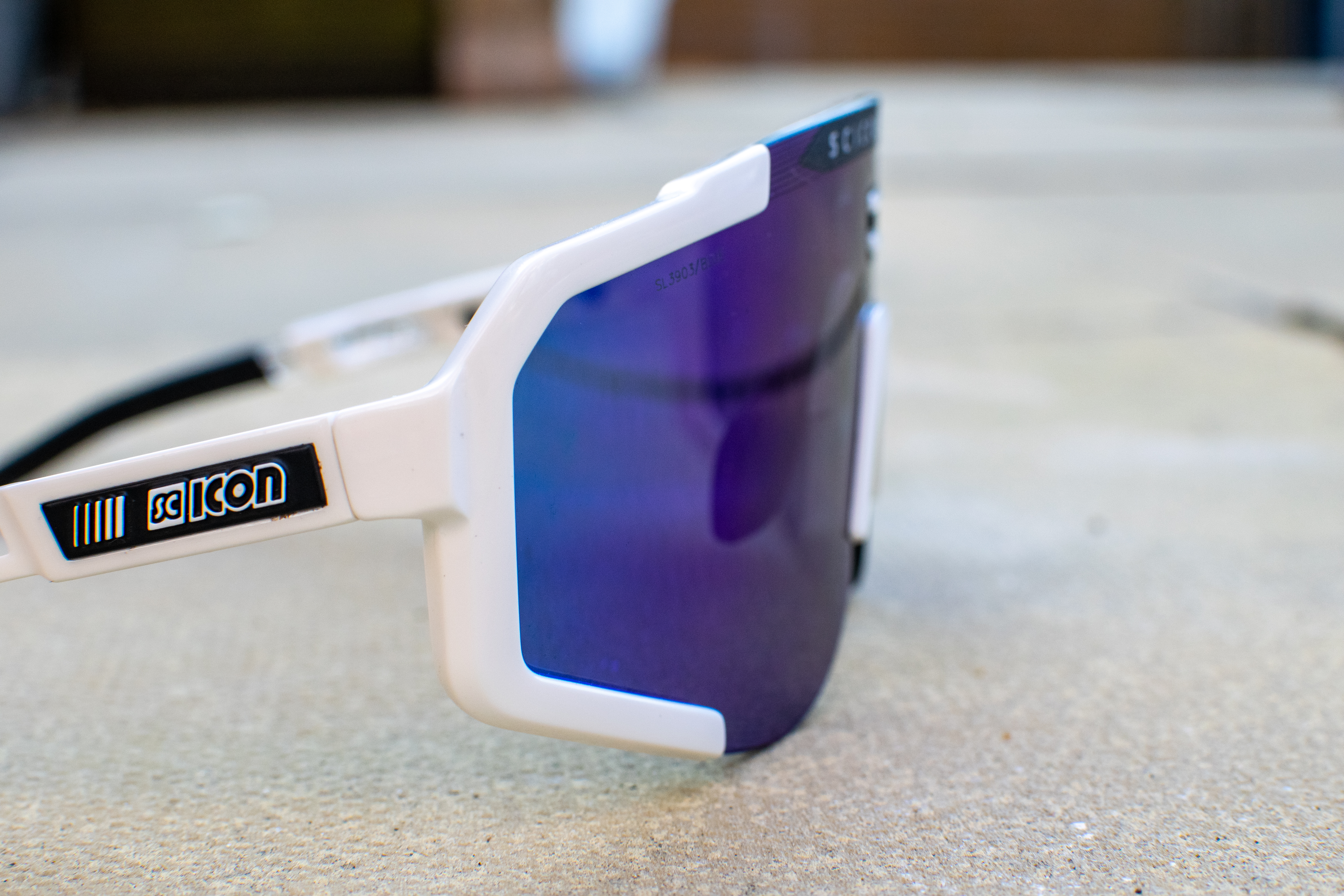
Value
These shades at £195 / $230 / €250 are slap bang in the price range of a host of premium cycling and sports glasses. There's competition here from Oakley, 100% and brands like Roka.
The quality all checks out to me, the glasses feel premium, and I haven't found fault of any kind with the manufacturing.
I also like what you get out of the box: a saddlebag-style case with a neat mini carabiner, soft lens bag, spare lens, and the sunglasses themselves, of course.
Throw in Scicon's scratch replacement policy, and as long as you keep the paperwork, it's an offering that certainly boosts the value of these sunglasses in a big way.
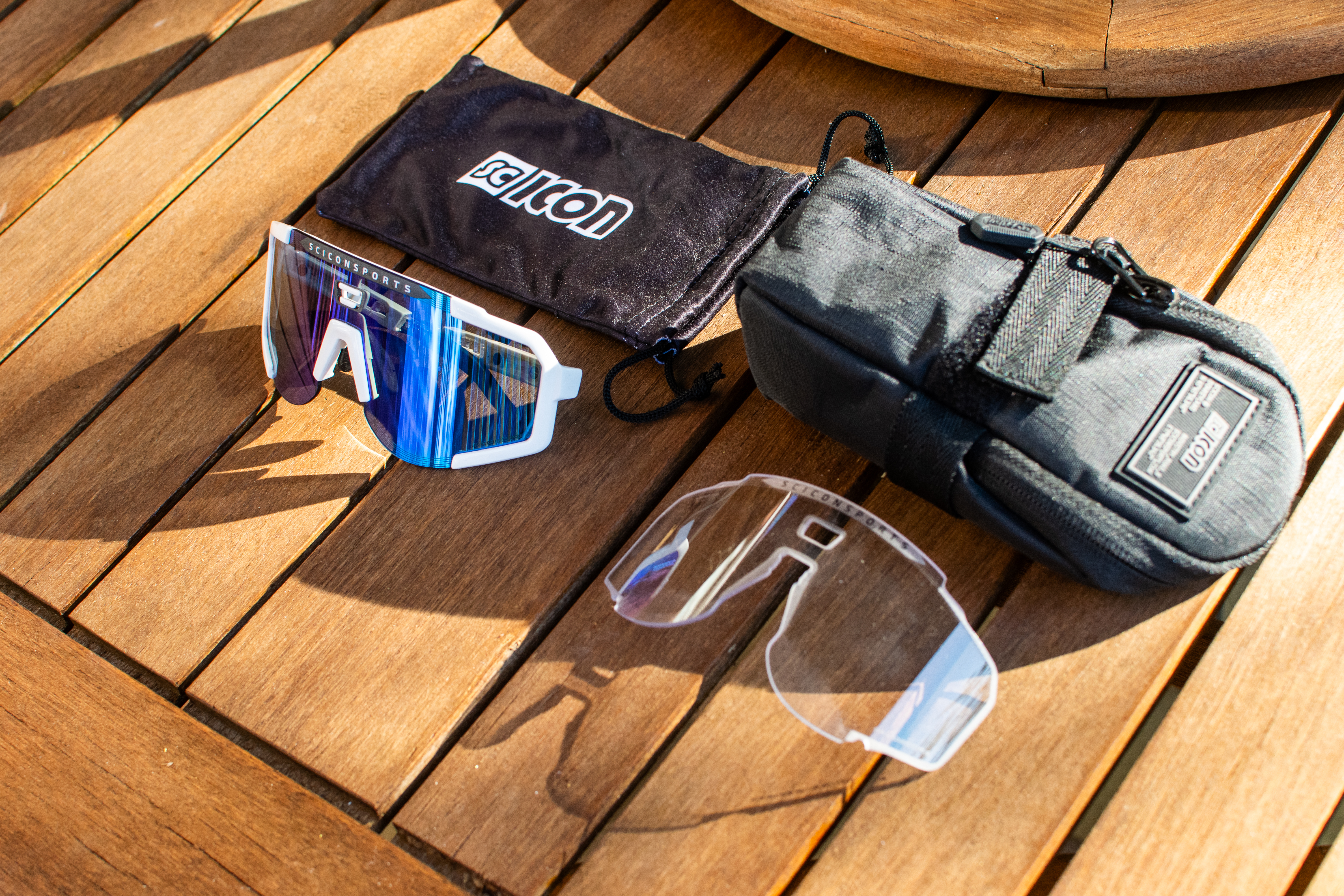
Verdict
These are high-quality performance cycling glasses, and I can tell Scicon has put plenty of thought into the design.
I like the overall styling, and the lens quality is beyond question. Negatives for me are the less comfortable hard rubber nose piece and the fact that the frame obscures your line of sight when looking over the shoulder.
I also think the value proposition isn't bad for the price, as mentioned, you're getting a nice bundle out of the box, and the Scicon Care lens replacement offer is nice.
I have worn these shades for hours in a range of conditions without an issue, but they aren't quite perfect for me.
| Row 0 - Cell 0 | Row 0 - Cell 1 | Row 0 - Cell 2 |
| Design and aesthetics | A large up to date frame design and wide range of options are available. | 8/10 |
| Field of vision | Very good thanks to the big lens, only compromise by the frame when looking over your shoulder | 7/10 |
| Lens performance | Excellent, zero complaints from me | 9/10 |
| Comfort and retention | Excellent retention, nose piece not quite as comfy for me | 7/10 |
| Value for Money | Good, included spare lens, two bags and a free lens replacement | 8/10 |
| Overally rating | Row 6 - Cell 1 | 39/50 (78%) |

Tom joined the Cyclingnews team in late 2022 as a tech writer. Despite having a degree in English Literature he has spent his entire working life in the cycling industry in one form or another. He has over 10 years of experience as a qualified mechanic, with the last five years before joining Cyclingnews being spent running an independent workshop. This means he is just as happy tinkering away in the garage as he is out on the road bike, and he isn’t afraid to pull a bike apart or get hands-on with it when testing to really see what it’s made of.
He has ridden and raced bikes from an early age up to a national level on the road and track, and has ridden and competed in most disciplines. He has a keen eye for pro-team tech and enjoys spotting new or interesting components in the wild. During his time at Cyclingnews, Tom has already interviewed some of the sport's biggest names including Mathieu van der Poel, Tadej Pogačar and Alberto Contador. He's also covered various launches from brands such as Pinarello, Ridley, Specialized and more, tackled the Roubaix Challenge sportive aboard his own rim-brake Cannondale SuperSix Evo, tested over 20 aero helmets in the wind tunnel, and has created helpful in-depth buying advice relating to countless categories from torque wrenches to winter clothing.
You must confirm your public display name before commenting
Please logout and then login again, you will then be prompted to enter your display name.
